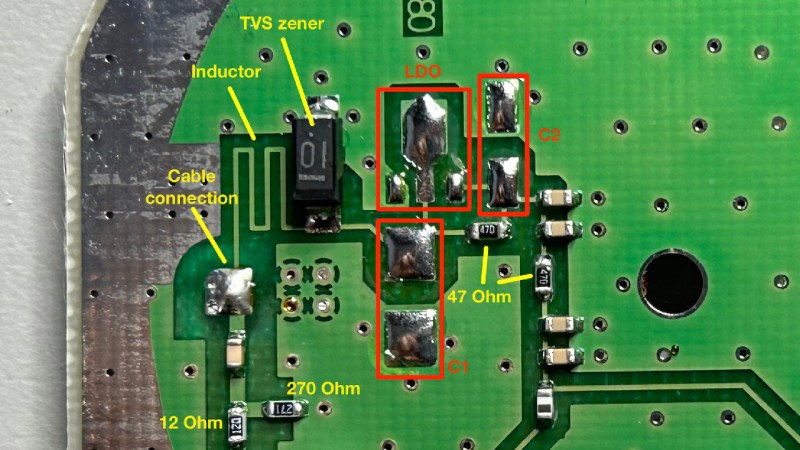GPS can be a bit complex of a technology – you have to receive a signal below the noise floor, do quite a bit of math that relies on the theory of relativity, and, adding insult to injury, you also have to go outside to test it. Have you ever wondered how GPS antennas work? In particular, how do active GPS antennas get power down the same wire that they use to send signal to the receiver? Wonder not, because [Tom Verbeure] gifts us a post detailing a mod letting a fancy active GPS antenna use a higher-than-expected input voltage.
[Tom]’s post has the perfect amount of detail – enough pictures to illustrate the entire journey, and explanations to go with all of it. The specific task is modifying a Symmetricom antenna to work with a Symmetricom GPS receiver, which has a puzzling attribute of supplying 12V to the antenna instead of more common 3.3V or 5V. There’s a few possible options detailed, and [Tom] goes for the cleanest possible one – replacing the voltage regulator used inside of the antenna.
With a suitable replacement regulator installed and a protection diode replaced, the antenna no longer registers as a short circuit, and gets [Tom] a fix – you, in turn, get a stellar primer on how exactly active GPS antennas work. If your device isn’t ready to use active GPS antennas, [Tom]’s post will help you understand another GPS antenna hack we covered recently – modifying the Starlink dish to use an active antenna to avoid jamming on the frontlines.
















quantum mechanics? no. relativity? yes.
I swear, both have achieved such a status as hand-wavy magic that people start to use them as interchangeable science babble.
I am pretty sure it not both. Getting the signal out of the noise floor is done with with pure math and probability not quantum mechanics involved
Proper function of the global positioning system (GPS) requires that you account for relativity.
Time is different between the satellite orbits and the surface of the Earth. This is due to the effects of the Earth’s mass – that’s a relativity related effect.
If you don’t account for relativity, the results are useless.
Picking the signal out of the noise relies on some truly complicated math. The end result of all that math is that the satellites are transmitting a signal with some megahertz of bandwidth to carry a datastream of only a couple of hundred bits per second.
How it works is fascinating.
https://en.wikipedia.org/wiki/Global_Positioning_System
Here’s an interesting document from the DoD against that claim that no relativistic effects are involved: https://apps.dtic.mil/sti/tr/pdf/ADA158720.pdf. It’s worth a read!
Abstract:
A group of scientists have for a number of years been claiming that relativistic
corrections are not taken into account in GPS system design. Rather, they claim that
there are fundamental errors in system design having to do with relativity theory,
and that the system will consequently fail to meet its specifications.
DARPA requested that JASON consider the issue during its 1984 Summer Study. Our
major conclusion is that these claims about GPS are completely invalid; the fundamentals of relativistic time synchronization on which the system is based are valid.
that is not how I am reading this abstract? I interpret it as “scientists are claiming there are relativity-related problems in the system”, which doesn’t mean the accounted-for relativity-related fundamentals are not correct, and the “the fundamentals of relativistic time synchronization on which the system is based are valid” part confirms that for me.
You and I are reading the abstract the same way! IOW: relativistic effects are definitely in play and must be taken into account.
o h I’ve misread your comment, specifically, the “against that claim” part =D
oop, yes, absolutely, my bad! physics doesn’t stick in my brain well, so it’s easy to confuse the two.
The GPS operators at US space command adjust the clocks for relativistic shift. You don’t need to. The rest of the error is adjusted for by frame shift and then diff GPS, or now an inffered Diff GPS from ground sources.